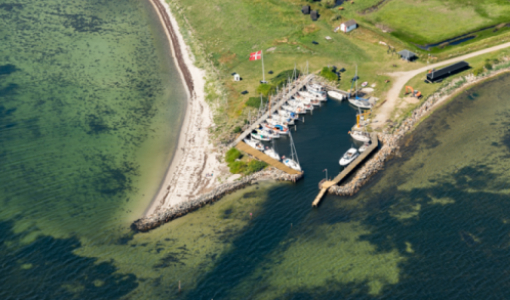On November 12–14 1872, the southern part of Denmark experienced a violent flood. It cost 270 people their lives, and the water was gauged at as much as 3.3 metres (11 ft.) above mean sea level.
The highest point on the island Birkholm is no more than 2 metres (6.6 ft.), and the islanders had experienced floods many times before. Since the 18th century, the residents had constructed and maintained dikes made of seaweed, which had, until the flood in 1872, kept the water out of the cultivated fields whenever the fall and winter storms raged and sent floods across the island. But the flood in 1872 was the worst ever in Denmark.
Back then, 89 people lived on Birkholm. They put their trust in the 2-metres high and 4-metres wide seaweed dikes that had protected the island against the salty water since their construction. But when the water continued to rise over the dikes on this November day, the islanders sought refuge in the attics and outside on the roofs of their houses.
The water flooded the entire island, and all the houses were underwater. All Birkholm’s islanders survived, but the destruction caused by the water was complete, and almost all livestock on the island were dead. Only two houses still stood after the flood.
No more than two years later, disaster struck again. Another storm surge flooded Birkholm in 1874, and the seaweed dikes were once again unable to withstand the huge amounts of water. The rebuilt houses and farms fared better, but the water left the fields ruined by salt water, rendering them uncultivable for many years to come.
The broken dikes had to be rebuilt, and it was clear that there was a need for permanent dikes instead of the seaweed dikes. The work of constructing two permanent dikes on Birkholm was initiated in 1875, and they are still there to this day, ready to protect the island. The village dike encircling the houses on the island is 2.8 metres (9 ft.) tall and 2100 metres (1.3 miles) long. Further out are the lower sea dikes.
It is not hard to imagine that the maintenance of the dikes is crucial to the island’s residents. The outer dikes are broken through every year, but the village dike has not been broken through since its construction in 1875. The island’s residents collaborate to make sure the dikes are maintained all year round.
The Birkholm resident’s association recommend that visitors to the island show respect for the dikes and wildlife on the island. They request that visitors enjoy Birkholm’s beautiful nature with consideration and prefer that dogs are kept on a leash.
Explore exciting stories from the small islands.
Learn more about Birkholm Harbor here.
Sources: Birkholm residents' association
Marstal Maritime Museum: https://marmus.dk/images/pdf/download/Da%20vandene%20steg.pdf
